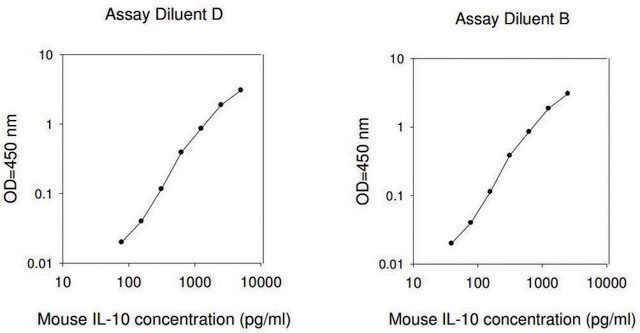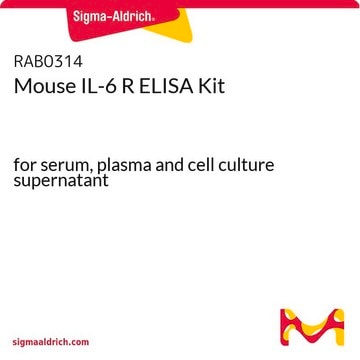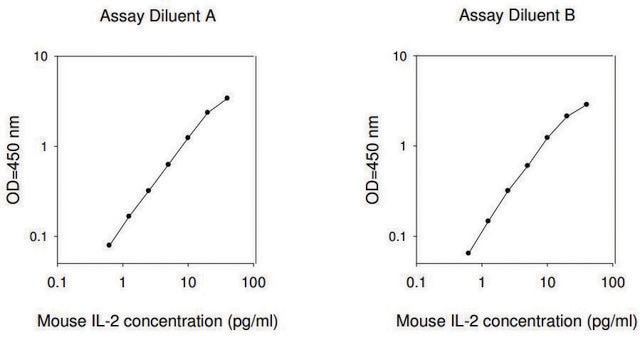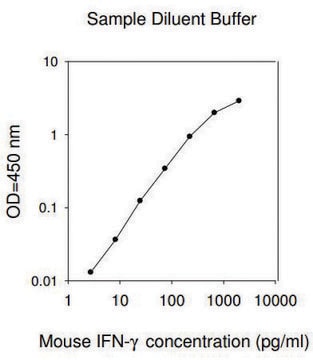The Assay/Sample Diluent Buffer (Item E2) should be diluted 5-fold. This 1X Assay/Sample Diluent Buffer is used to dilute serum, plasma, or medium samples a recommended 2 fold. Please note that the levels of IL-6 may vary between different samples. Optimal dilution factors for each sample must be determined by the investigator.
RAB0308
Mouse IL-6 ELISA Kit
for serum, plasma and cell culture supernatant
Synonim(y):
Czynnik różnicowania CTL, Czynnik stymulujący komórki B 2, Czynnik wzrostu hybrydoma, IFN-beta-2, IL-6, Interferon beta-2
Wybierz wielkość
2350,00 zł
Wybierz wielkość
About This Item
2350,00 zł
Polecane produkty
reaktywność gatunkowa
mouse
opakowanie
kit of 96 wells (12 strips x 8 wells)
metody
ELISA: suitable
capture ELISA: suitable
moc wejściowa
sample type plasma
sample type cell culture supernatant(s)
sample type serum
assay range
inter-assay cv: <12%
intra-assay cv: <10%
sensitivity: 2 pg/mL
standard curve range: 0.82-600 pg/mL
metoda wykrywania
colorimetric
Warunki transportu
wet ice
temp. przechowywania
−20°C
informacje o genach
mouse ... Il6(24498)
Powiązane kategorie
Opis ogólny
Immunogen
Zastosowanie
Działania biochem./fizjol.
Inne uwagi
Please type the word sample in the text box provided for lot number.
Elementy zestawu są też dostępne oddzielnie
polecane
Hasło ostrzegawcze
Warning
Zwroty wskazujące rodzaj zagrożenia
Zwroty wskazujące środki ostrożności
Klasyfikacja zagrożeń
Met. Corr. 1
Kod klasy składowania
8A - Combustible corrosive hazardous materials
Wybierz jedną z najnowszych wersji:
Masz już ten produkt?
Dokumenty związane z niedawno zakupionymi produktami zostały zamieszczone w Bibliotece dokumentów.
Klienci oglądali również te produkty
-
Hello. How much should I dilute tissue culture media for the assay? 2-fold? Thanks.
1 answer-
Helpful?
-
-
マウスのパイエル板をホモジナイズした上清で測定は可能ですか?
1 answer-
This product is suitable with serum, plasma, and cell culture supernatant. However, it has not been determined if this product can measure the supernatant obtained by homogenizing mouse Peyer's patches. This application will need to be validated by the end-user.
While the requested ELISA kit nor any of the offered normal ELISA kits are neither designed nor validated with cell/tissue lysate samples, our kits are very accommodating to many different sample types so lysates will most likely work. If it is decided to test these kits with cell/tissue lysate samples, it is recommended to dilute the samples at least 5-fold with Assay Diluent to minimize any effects of the detergents in the lysis buffer. The samples may need to be diluted further but this would need to be determined by the experimenter empirically.
So for the original lysate, in general it is recommended to shoot for at least 1 mg/ml protein, preferably more, to achieve 50-500 ug/ml after dilution. Again though, this range should just be used as a starting point and the optimal concentration would need to be determined empirically.
Below are some general guidelines for doing so along with some basic tips for sample preparation.
Tips on Sample preparation
In brief, a lysis buffer must meet the following specifications:
A) has relatively low salt content (700 mM or less)
B) does not contain sodium azide
C) does not contain >0.1% SDS
D) does not contain >10 mM reducing agents (beta-mercaptoethanol or dithiothreitol)
This would include any buffers used for immunoprecipitations, including RIPA buffer.Helpful?
-
Active Filters
Nasz zespół naukowców ma doświadczenie we wszystkich obszarach badań, w tym w naukach przyrodniczych, materiałoznawstwie, syntezie chemicznej, chromatografii, analityce i wielu innych dziedzinach.
Skontaktuj się z zespołem ds. pomocy technicznej

















